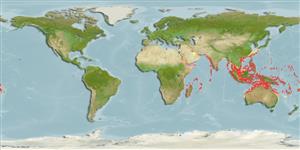Environment: milieu / climate zone / depth range / distribution range
Ökologie
seewasser riff-verbunden; tiefenbereich 20 - 100 m (Ref. 90102), usually 40 - 54 m (Ref. 9710). Tropical
Indo-West Pacific: East Africa, Maldives and Indonesia.
Size / Gewicht / Alter
Maturity: Lm ? range ? - ? cm
Max length : 14.0 cm TL Männchen/unbestimmt; (Ref. 8631)
Rückenflossenstacheln (insgesamt): 10; Rückenflossenweichstrahlen (insgesamt): 16; Afterflossenstacheln 3; Afterflossenweichstrahlen: 7 - 8. Displays different or stronger color patterns when living together with similar looking species to enhance recognition by females which may lead to further speciation (Ref. 48635).
Inhabits deep coastal drop-offs (Ref. 8631, 48635). In Java Sea, taken only in dead reef areas in somewhat turbid water (Ref. 8926). Closely related species such as P. pleurotaenia and P. bimaculatus may spawn at the same time and produce accidental hybrids (Ref. 48635).
Life cycle and mating behavior
Geschlechtsreife | Fortpflanzung | Ablaichen | Eier | Fecundity | Larven
Randall, J.E. and M. Hutomo, 1988. Redescription of the Indo-Pacific serranid fish Pseudanthias bimaculatus (Smith). Copeia 1988(3):669-673. (Ref. 8926)
IUCN Rote Liste Status (Ref. 130435)
Bedrohung für Menschen
Harmless
Nutzung durch Menschen
Fischereien: nicht kommerziell; Aquarium: Kommerziell
Mehr Information
NamenSynonymeMetabolismusRäuberÖkotoxikologieFortpflanzungGeschlechtsreifeAblaichenSpawning aggregationFecundityEierEientwicklung
ReferenzenAquakulturAquakultur ProfilZuchtlinienGenetikElectrophoresesVererbbarkeitKrankheitenVerarbeitungNutrientsMass conversion
PartnerBilderStamps, Coins Misc.LauteCiguateraGeschwindigkeitSchwimmstilKiemenoberflächeOtolithsGehirngrößeSehfähigkeit
Tools
Zusatzinformationen
Download XML
Internet Quellen
Estimates based on models
Preferred temperature (Ref.
123201): 25.6 - 28.4, mean 27.4 °C (based on 264 cells).
Phylogenetic diversity index (Ref.
82804): PD
50 = 0.5000 [Uniqueness, from 0.5 = low to 2.0 = high].
Trophic level (Ref.
69278): 3.4 ±0.4 se; based on size and trophs of closest relatives
Widerstandsfähigkeit (Ref.
120179): hoch, Verdopplung der Population dauert weniger als 15 Monate. (Preliminary K or Fecundity.).
Fishing Vulnerability (Ref.
59153): Low vulnerability (10 of 100).
